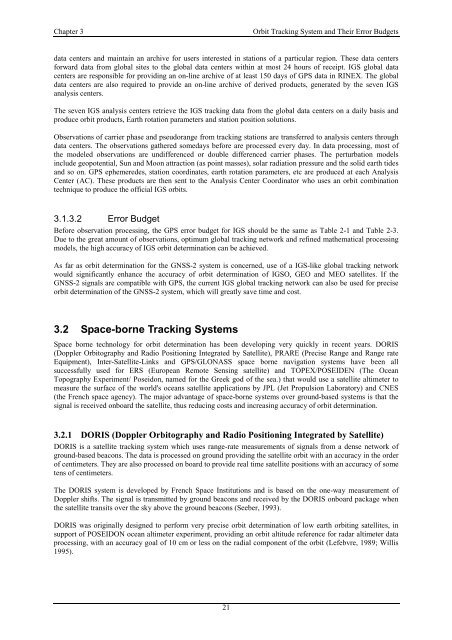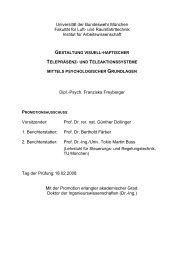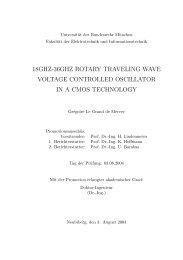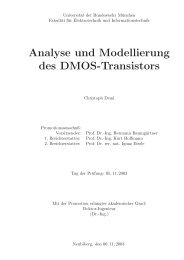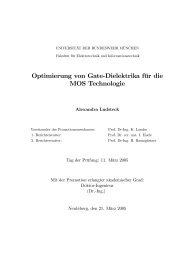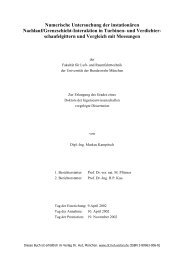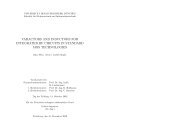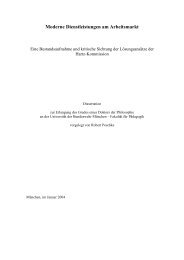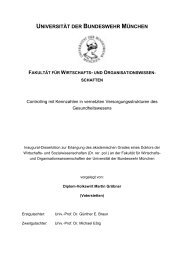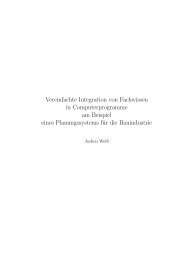Precise Orbit Determination of Global Navigation Satellite System of ...
Precise Orbit Determination of Global Navigation Satellite System of ...
Precise Orbit Determination of Global Navigation Satellite System of ...
You also want an ePaper? Increase the reach of your titles
YUMPU automatically turns print PDFs into web optimized ePapers that Google loves.
Chapter 3 <strong>Orbit</strong> Tracking <strong>System</strong> and Their Error Budgets<br />
data centers and maintain an archive for users interested in stations <strong>of</strong> a particular region. These data centers<br />
forward data from global sites to the global data centers within at most 24 hours <strong>of</strong> receipt. IGS global data<br />
centers are responsible for providing an on-line archive <strong>of</strong> at least 150 days <strong>of</strong> GPS data in RINEX. The global<br />
data centers are also required to provide an on-line archive <strong>of</strong> derived products, generated by the seven IGS<br />
analysis centers.<br />
The seven IGS analysis centers retrieve the IGS tracking data from the global data centers on a daily basis and<br />
produce orbit products, Earth rotation parameters and station position solutions.<br />
Observations <strong>of</strong> carrier phase and pseudorange from tracking stations are transferred to analysis centers through<br />
data centers. The observations gathered somedays before are processed every day. In data processing, most <strong>of</strong><br />
the modeled observations are undifferenced or double differenced carrier phases. The perturbation models<br />
include geopotential, Sun and Moon attraction (as point masses), solar radiation pressure and the solid earth tides<br />
and so on. GPS ephemeredes, station coordinates, earth rotation parameters, etc are produced at each Analysis<br />
Center (AC). These products are then sent to the Analysis Center Coordinator who uses an orbit combination<br />
technique to produce the <strong>of</strong>ficial IGS orbits.<br />
3.1.3.2 Error Budget<br />
Before observation processing, the GPS error budget for IGS should be the same as Table 2-1 and Table 2-3.<br />
Due to the great amount <strong>of</strong> observations, optimum global tracking network and refined mathematical processing<br />
models, the high accuracy <strong>of</strong> IGS orbit determination can be achieved.<br />
As far as orbit determination for the GNSS-2 system is concerned, use <strong>of</strong> a IGS-like global tracking network<br />
would significantly enhance the accuracy <strong>of</strong> orbit determination <strong>of</strong> IGSO, GEO and MEO satellites. If the<br />
GNSS-2 signals are compatible with GPS, the current IGS global tracking network can also be used for precise<br />
orbit determination <strong>of</strong> the GNSS-2 system, which will greatly save time and cost.<br />
3.2 Space-borne Tracking <strong>System</strong>s<br />
Space borne technology for orbit determination has been developing very quickly in recent years. DORIS<br />
(Doppler <strong>Orbit</strong>ography and Radio Positioning Integrated by <strong>Satellite</strong>), PRARE (<strong>Precise</strong> Range and Range rate<br />
Equipment), Inter-<strong>Satellite</strong>-Links and GPS/GLONASS space borne navigation systems have been all<br />
successfully used for ERS (European Remote Sensing satellite) and TOPEX/POSEIDEN (The Ocean<br />
Topography Experiment/ Poseidon, named for the Greek god <strong>of</strong> the sea.) that would use a satellite altimeter to<br />
measure the surface <strong>of</strong> the world's oceans satellite applications by JPL (Jet Propulsion Laboratory) and CNES<br />
(the French space agency). The major advantage <strong>of</strong> space-borne systems over ground-based systems is that the<br />
signal is received onboard the satellite, thus reducing costs and increasing accuracy <strong>of</strong> orbit determination.<br />
3.2.1 DORIS (Doppler <strong>Orbit</strong>ography and Radio Positioning Integrated by <strong>Satellite</strong>)<br />
DORIS is a satellite tracking system which uses range-rate measurements <strong>of</strong> signals from a dense network <strong>of</strong><br />
ground-based beacons. The data is processed on ground providing the satellite orbit with an accuracy in the order<br />
<strong>of</strong> centimeters. They are also processed on board to provide real time satellite positions with an accuracy <strong>of</strong> some<br />
tens <strong>of</strong> centimeters.<br />
The DORIS system is developed by French Space Institutions and is based on the one-way measurement <strong>of</strong><br />
Doppler shifts. The signal is transmitted by ground beacons and received by the DORIS onboard package when<br />
the satellite transits over the sky above the ground beacons (Seeber, 1993).<br />
DORIS was originally designed to perform very precise orbit determination <strong>of</strong> low earth orbiting satellites, in<br />
support <strong>of</strong> POSEIDON ocean altimeter experiment, providing an orbit altitude reference for radar altimeter data<br />
processing, with an accuracy goal <strong>of</strong> 10 cm or less on the radial component <strong>of</strong> the orbit (Lefebvre, 1989; Willis<br />
1995).<br />
21


